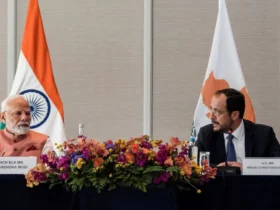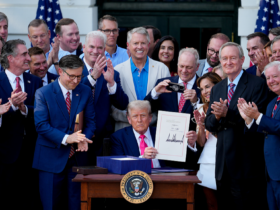By Sigfrido Reyes
Sigfrido Reyes is member of the Farabundo Martí National Liberation Front of El Salvador. He served as the President of the Legislative Assembly of El Salvador from 2011 to 2015.
Reyes delivered the following speech to the International Congress “Political Parties and a New Society” organized by the Labor Party (Mexico) and held in Mexico City 21st to 23rd of October 2021.
The speech compares the foreign policy and global positioning of the Trump and Biden administrations. The text was translated by Yunus Soner. Subheadtitles belong to Sigfrido Reyes.
1. Where did Trump leave the United States on the global chessboard?
At the beginning of 2017, there was a significant shift in the foreign policy of the United States – a shift that directly affected the way in which the United States, the nation with the greatest economic, military and technological power on the planet, would relate to the rest of the world, causing the other major powers and generally the nations of the world to rearrange their relations of all kinds with Washington too.
The arrival of Donald Trump, a wealthy real estate magnate and representative at that time of ultraconservative thought in the United States with all kinds of political and economic interests behind him, to the White House immediately impacted on the geopolitical board world. Under the slogan of “Make America Great Again”[1], the so-called “hawks” in Washington, who had been out of the Administration since George Bush’s departure from power in January 2009, were back on their feet to rethink their strategies for global domination, under the in light of evidence quite questionable assumption, that the Democrats under Obama and Biden had practiced policies that led to the weakening of US power and its role as the hegemonic superpower in the world.
The following 4 years, the international environment found itself subjected to markedly surprising, unilateral and generally aggressive decisions by Trump, leading the world to unusually high levels of tension and mutual misgivings, weakening the prospects for a multilateral and negotiated solution to major problems that concern humanity, such as the containment of the nuclear arms race, the mitigation of climate change, the reduction of sources of military conflict, the ordering of migratory flows, commercial and financial imbalances, the development and access to the most advanced communication technologies and control of infectious diseases etc.
In a short time the world entered a new scenario, marked by growing mistrust and the dismantling of agreements that had cost years of careful and complex negotiations. Trump, following the agenda of the ultra-conservative interests of the United States, launched to dismantle agreements on arms control, such as START II [2], the INF[3] and the Open Skies Treaty[4], all agreed with Russia, and committed to an aggressive policy of sanctions of all kinds against its main military rival.
In relation to China, a unilateral policy of imposing trade tariffs was launched in addition to torpedoing the diffusion of Chinese technologies in the field of ICT[5], particularly those related to 5G solutions designed by the tech giants of that Asian nation, Huawei and ZTE. Likewise, a rapprochement with the separatist authorities of Taiwan and the destabilizing movements within Hong Kong and other provinces within the Chinese mainland were started. Trump and his close collaborators turned anti-Chinese rhetoric into one of the main discursive axes throughout their term, crowned by the demagogic and irresponsible claim that China was behind the creation of the SARS-Cov-2 virus. All this was accompanied by a growing hysteria around an imaginary “growing military threat from China”.
Along the same aggressive lines, Trump dynamited the so-called Nuclear Agreement on Iran[6], negotiated for years with the participation of Russia, China, France, Great Britain and Germany, plus the support of the European Union. That agreement had endorsed the peaceful nuclear development of the Persian nation under international supervision and accompanied by the lifting of the drastic measures that blocked the Iranian economy, formerly promoted by Washington.
The initial aggressive rhetoric against North Korea was soon followed by an unusual personal rapprochement by Trump with North Korean leader Kim Jong-un, a rapprochement that did not ultimately reduce tensions on the Korean Peninsula, given Washington’s refusal to dismantle its military facilities in South Korea, to end their military exercises and to commit not to attack the Democratic People’s Republic of Korea.
In relation to another burning issue on the international agenda, that is the Palestinian-Israeli conflict, Trump did nothing but to bury the possibilities of resuming the path of negotiations between the parties with a view to finally establishing a 2-State solution, including a viable, sovereign and independent Palestinian state. On the contrary, the unconditional support for the Zionist government of Netanyahu, symbolized by the transfer of the United States Embassy to Jerusalem, and the sponsorship of the so-called “Deal of the Century”, for the moment closed any possibility of establishing a Palestinian state, exacerbated the dismantling of Palestinian society, and has only served to keep tensions alive in the Middle East region, with a Palestinian people increasingly humiliated, encircled and desperate, reinforcing Israel’s co-imperialist role in the region, with the complicity of the reactionary Arab monarchies, including more recently the one headed by Hassan II in Morocco.
Trump not only applied unilateral and aggressive measures against those who, in the eyes of the conservative establishment, be it Republican or Democratic, are reputed as enemies or rivals. His own allies were subjected to various punishments and / or humiliating actions. In military matters, Trump pressured his NATO partners to significantly increase their defense budgets, presented them with fait accompli in relation to Russia and Iran, and pressured them to continue their participation in the occupation of Afghanistan, among other measures.
In the commercial and technological sphere, he unilaterally imposed tariffs on steel and a series of key products for the economies of the member countries of the European Union, while supporting without any dissimulation the exit of Great Britain from the Union. He coerced several of those allied countries to desist from their plans to acquire 5G technology exported by China and openly opposed the Nord Stream II project, designed to ensure the supply of natural gas to the community space and alleviate Europe’s dependence on fossil fuels from third countries. And if the foregoing were not enough, Trump lashed out at the Paris Agreements on climate change, a bet that Europe had considered a priority.
Other traditional allies of the United States such as Japan, Australia and other Southeast Asian countries, such as the Philippines and Indonesia, were also mocked by Washington, when Trump decided that his country would not ratify the Trans-Pacific Partnership Agreement negotiated by the Obama Administration as a commercial containment weapon against the emergence of China as the undisputed economic power in the Asia-Pacific.
Latin America also felt the resurgence of the imperialist policy of the United States. Aligned with the ultra-right of Cuban origin in Florida, Trump redoubled the blockade against Cuba, escalated to unprecedented levels the political, diplomatic and economic aggression against Venezuela, openly supported the destabilizing and bloody actions of the Nicaraguan right, and provided unconditional support to rightist regimes in Brazil, El Salvador, Colombia, Honduras, Chile and others. The zenith of its interventionist policy was expressed in its open support for the coup d’état perpetrated by the Bolivian right, under the political cover of the OAS, against the Government of Evo Morales.
Words more, words less, and after his failed re-election in November 2020, this is how Trump left the international stage to incoming President Joe Biden and the Democrats, who returned to the White House in January 2021.
2. Biden-Harris’ campaign promises
The election campaign for the Presidency of the United States in 2020 was marked by intense debates about the role of that country in the world. The Democratic Party’s allegations of Trump’s foreign policy and its results were devastating: in less than 4 years, Trump had isolated the country from the rest of the world, while loosing the sympathy of his traditional allies. He had embarked on an unproductive confrontation with Russia and China, he was supporting anti-democratic, corrupt and human rights violating regimes and, generally, his actions had awakened feelings of rejection towards the United States all over the globe.
The answer had to be, in the view of candidate Biden, a drastic turn of the wheel, which involved a return to traditional liberal values in foreign policy. Specifically, Biden promised in his campaign to bet again on multilateralism to face burning problems that challenge humanity, rebuild relations with his allies and adopt a more pragmatic and constructive tone with his declared rivals. Privileging diplomacy, dialogue, cooperation and betting on peace would be the central axes that would sustain the foreign policy of the Democrats in this new stage.
More specifically, Biden offered to return to the nuclear arms control and limitation agreements, abandoned by Trump, to rejoin the United States to the Nuclear Agreement on Iran, to limit military support to the Saudi monarchy in its adventure in Yemen and to complete the exit from Afghanistan. He also promised to return to the agreements on climate change, overcoming the denial of his predecessor regarding the serious and imminent danger of global warming.
For Latin America, his main offer was focused on launching a new migration policy, which would reestablish the right to asylum and implement a more humane treatment of migrants, favoring legal and orderly migration. On the political and diplomatic level, he offered to return to the path of detente with Cuba, lifting the more than 200 new sanctions ordered by Donald Trump to suffocate the island’s economy. It should be noted that in relation to Venezuela, both candidates, Democrats and Republican, made an effort to appear each one more radical than the other, defending the policy of subversion and an almost total economic blockade of the South American country.
In short, Biden promised US voters to regain the global trust of their interlocutors, be they ally or adversary, and to retake what they themselves have dubbed “American leadership.” Everything could be reflected in a campaign slogan: “America is back again!” To give strength to his promises, Biden used to his advantage his long experience in foreign policy and national security, accumulated in several decades of public service, as Chairman or high-ranking member of the Senate Foreign Relations Committee, and later as Vice Chairman of the Senate and Vice President of the United States for 8 years.
3. Biden’s first 9 months in the White House
At the opening session of the 76th UN General Assembly held last September, Joe Biden appeared for the first time in his new capacity as President of the greatest global power to deliver a speech on his vision of the world and the role of his country. Biden did not miss the opportunity to reiterate his main guidelines on the matter. After the hasty departure from Afghanistan, he insisted that his country will change course and privilege the use of diplomacy over wars.
He re-emphasized his government’s commitment to human rights, placing human dignity as a central element that should not be ignored or misinterpreted[7]. But, at the same time that he raised the pacifist tone of his speech, he insisted on dividing the world between the United States and its allies on the one hand, and the rest of the international community on the other. In doing so, he did not stop appealing to North American exceptionalism, a doctrine that tries to justify a hegemonic, unique and privileged role of that country to lead humanity – a country that does not submit to the rules that it proclaims and demands for other nations.
In praxis, each aspect of the new orientation of US policy must be examined and dispassionately clarify what is really new and positive, and what survives from the disastrous foreign policy of Donald Trump and his court of ultra-conservative fanatics. The elections have already passed and what we have in view are not promises and proposals aimed at winning votes, but specific actions and concrete behaviors, which are visible to everyone.
In this perspective, Washington’s policy towards China is undoubtedly an issue that cannot escape analysis. There is no evidence that Biden and his advisers are willing to abandon the hard line adopted by the previous Administration. On the contrary, Biden proposed, and succeeded, at the US-European Union Summit last June, elevating China to the status of a common strategic challenge, raising the tone of the rivalry with Beijing.
Along these lines, the large-scale trade conflict has not been dismantled in the slightest, and the rhetoric against Beijing remains at the same aggressive levels as just a while ago, including the repeated attempt to blame China for the COVID-19 crisis, regardless of the robust conclusions of a WHO scientific panel that worked for weeks in China, trying to corroborate or discard various hypotheses about the origin of the coronavirus. It is otherwise interesting that despite the trade retaliation adopted in the Trump era, the trade deficit with China remains and continues to increase[8].
China had pledged to buy $ 200 billion worth of additional US products over two years, including agricultural products, energy sector goods and manufacturing, with the aim of reducing the trade imbalance between both countries. The agreement signed in mid-January 2020 between Donald Trump and Chinese Vice Premier Liu He had allowed a truce in the war between the United States and China, which had slowed the growth of both countries. But for one reason or another the figures indicate that the trade imbalance between the two nations will not be easy to overcome.
Although attempts have been made to improve bilateral relations, the results so far are meager. In March a high-level meeting was held in Anchorage, Alaska, to seek rapprochement, but it only served to highlight the sharp differences between both parties on a series of issues where they antagonize. An evidence of the rarefied climate in the relationship between the two powers is that, to date, there has been no summit between Biden and Chinese leader Xi Jinping. On October 6, Biden’s National Security Advisor, Jake Sullivan and Beijing’s high-level diplomatic envoy, Yang Jiechi, met in Zurich, Switzerland. Finally, and although both parties kept their positions unchanged, they finally agreed to hold a virtual summit meeting between the two leaders, before the end of the year.
Washington’s actions that seek to create a strategic fence around China help nothing in this regard. Beyond the already frequent situations facing air and naval units from both sides in the maritime periphery of China, particularly in the South Sea or South China Sea, at least 2 far-reaching initiatives are underway by the United States in its approach to strategic containment, which definitely increase the misgivings of the Chinese side. The first has to do with the talks with Japan, South Korea and India, to incorporate these countries, with old rivalries with respect to China, to the sophisticated system of espionage and electronic surveillance commonly known as “The 5 Eyes”, commanded by States. United[9]. The second, the most recent, is the announcement of the AUKUS military pact, which would align Australia, Great Britain and the United States on a single axis in the Indo-Pacific region, with the no-secret objective of putting pressure on China.
The widely publicized approaches to Taiwan by Washington, redoubled by Trump and continued by Biden, are setting bilateral tensions on further fire. So are the largely disguised displays of Washington’s support for separatist movements in Hong Kong and Xinjiang province.
In relation to Russia, the policy of the Democratic government in Washington does not show any signs of departing from the confrontational tone of the past. Admittedly, Biden quickly agreed, after returning to the White House, to extend by mutual agreement the START II Treaty, which was about to expire, which would have launched the world into an unrestrained nuclear arms spiral. It was obvious that there was, and is, a particular interest in keeping the nuclear status quo at the present level. In line with the above, a summit meeting was arranged between Vladimir Putin and Joe Biden in Geneva last June, which modestly contributed to lessen the accumulated tensions.
The Geneva Summit was preceded by outrageous personal statements by Biden regarding his Russian counterpart, and the holding of the NATO Assembly in Brussels, where Russia’s status as a rival to be weakened had been reaffirmed. At this point, Biden, in the same vein as his predecessor, was still openly pressing for an end to the Nord Stream II project, contrary to the German decision, quietly backed by other partners on the European continent, to take advantage of the expanded supply of Russian gas[10].
Obviously the climate of tension between Russia and the United States remains alive. Economic sanctions against Moscow remain in force, anti-Russian rhetoric does not give way to spokesmen for Washington. After the defeat of Hilary Clinton against Trump in November 2016, it was an easy resource for the Democrats to search for a culprit in Moscow, and thus the legend of Russian interference in the elections was born, which persecuted Trump throughout his term. In the last elections, the specter of that supposed interference rose again, causing both Democrats and Republicans to strive to convince voters on who was tougher and more forceful towards Moscow.
The line of confrontation in Washington that lately gains ground is that of the supposed cyber-attacks coming from Russia, which would be aimed at affecting vital interests of the Americans, such as the supply of fuel, energy and digital security. All of this serves as a pretext for new sanctions, and direct reprisals, such as the expulsion of Russian diplomats and the reduction of bilateral contacts. Another terrain of elevation of hysteria against Russia continues to be the situation in Eastern Ukraine, which remains under military control of groups disaffected to the Kiev regime, a close ally of Washington. The political events that have taken place in Belarus serve similar purposes, which are again used to reinforce the confrontation with Russia.
Trump left to Biden an extremely fragile situation regarding his relationship with several of his traditional allies. Europe clearly resented Trump’s trade decisions and the abrupt exit from the Paris Agreements on climate change. In terms of security, Trump’s sabotage of the Joint Comprehensive Plan of Action on Iran, which had been one of the priorities of the common foreign policy of the European Union, was not welcome. Not to mention the breaking of the INF Intermediate Missile Agreement, or the end of the Open Skies Treaty, decisions that directly and immediately impact European security interests.
Biden has tried from the beginning to rebuild ties with Europe, presenting himself as open to dialogue and taking into account the views and interests of his transatlantic partners, turning the page on the rugged and arrogant conduct of Trump and his emissaries. The June meetings with the European Union and NATO were devoted to these purposes. Nevertheless, the friction points in various fields remain. Trade sanctions on a number of European products and technologies, particularly in the field of commercial aviation, have not been dismantled. Disagreement on the Iranian nuclear issue persists, with Biden failing to comply with his offer to reinstate the deal that he himself backed when he was Obama’s vice president. The mutual recriminations around each other’s responsibilities for the failure in Afghanistan are public.
Probably one of the regions in the world where a substantial turnaround in North American policy was most expected was Latin America and the Caribbean. Trump went to great lengths to bring the Monroe Doctrine to life, in a crude and overbearing way. Since his electoral campaign in 2016, he has been an acid critic of the migration from this region, describing the migrants as vagabond people and inclined to crime. He came to describe certain countries as “shithole”, the equivalent of a toilet. Upon reaching the White House, he imposed on docile governments the so-called “Safe Third Country Agreements,” which opened the doors for Washington to violate its own asylum laws.
True to his outdated anti-communist vision, Trump set out to multiply unilateral and illegal measures to subdue Cuba and its Revolution, attacking in a particular way the economy of Cuban families, restricting the sending of remittances, limiting flights to the island and suspending the granting of visas to Cuban citizens. To justify this resurgence of the criminal blockade of Cuba, strange stories were invented, such as the imaginary acoustic wave attack on the US diplomatic headquarters in Havana.
With respect to Venezuela, orders were issued to deepen the economic and political aggression that had begun at the end of the Obama Administration, reaching the extreme of confiscating large assets of the Venezuelan State in North American territory, and escalating the aggression to the point of openly announcing its purpose: to achieve a “regime change” in Venezuela. To do this, they reinvented, to the point of grotesqueness, the figure of the President in Charge, prostituting a concept originally contemplated in the Bolivarian Constitution of Venezuela, and they put a puppet to cover that imaginary position, aligning his escalation to more than a dozen of right-wing governments in Latin America, and adding the support of some European governments. For this, Trump and his diplomatic apparatus were previously in charge of sabotaging the advanced political negotiations that the Government of President Nicolás Maduro and the Venezuelan opposition were holding with the support of the international community.
At the height of his aggressive insanity against Venezuela, Trump endorsed the plans to assassinate President Maduro and launched, in the midst of the COVID-19 crisis, on the adventure of criminal prosecution, within US jurisdiction, against the leaders of the Bolivarian Revolution, while the financial and commercial siege against the Venezuelan economy intensified.
With everything and the openly illegal and criminal of Trump’s policy towards Venezuela and Cuba, so far Biden shows no signs of deviating from that aggressive route. The more than 200 additional coercive measures against Cuba, added to the well-known blockade of more than 60 years, are still in force and harming the Cuban people. As for Venezuela, the pattern of conduct inherited from Trump continues, focused on subduing an entire people with the tools of hunger, scarcity, rationing and despair. The measures of economic warfare have had an impact on practically every area of life in Venezuelan society. And although in recent weeks the Government and the most radical and violent opposition, sponsored by Washington, have agreed on a common agenda to negotiate, it is not seen that the Biden Government likes this process.
In other countries in the region, such as Mexico, Trump’s policy also had adverse effects. In fact, Trump blackmailed Mexico into becoming a gigantic warehouse of migrants, who seek to flee insecurity and poverty in their countries. At the same time, it forced that country and its traditional partner Canada to renegotiate the North American Free Trade Agreement, in the interests of large US corporations.
In general, the Trump Administration’s policy toward its Southern Hemisphere neighbors was marked by arrogance, unilateralism, contempt, and xenophobia. At the same time, Trump openly pledged his support for right wing and repressive governments such as those of Colombia, Honduras, Brazil, El Salvador, Haiti, Ecuador and Chile, protagonists of massive human rights violations and acts of corruption. Not to mention the undisguised encouragement given to the strategy of arbitrary prosecution, known as lawfare, against leftist and progressive leaders in nearly all of those countries. Or the open political and financial support given to the violent right wing opposition in Nicaragua, which caused hundreds of victims and the almost paralysis of that country’s economy in 2018.
Clearly, the apogee of the right wing counteroffensive sponsored by Trump and his officials in Latin America was the coup d’état perpetrated against Evo Morales in Bolivia. In line with the traditional interventionist role assigned to the OAS, this time headed by Luis Almagro, who had turned into an agent of Washington, military and police sedition was encouraged and justified, and the coup regime that emerged from that stab at democracy was unconditionally supported. Bolivian.
4. Global powers and their response to US imperialist geopolitics
One thing is indisputably clear from the recent conduct of the United States as a global power: regardless of the more or less isolationist or globalist traits that each Government of that country, whether Republican or Democratic, imprints on its geopolitics towards the rest of the world, the imperialist character of their conduct remains unchanged.
While it is true that Trump’s actions in the White House and the operations carried out by his associates in the Pentagon, the State Department, the CIA, the NSA and other apparatuses that carry out foreign and security policy decisions, created stupefaction, frustrations and concern in all regions of the world, no less true is that the direction that the current Biden government is giving to that same geopolitical strategy differs very little from that of its predecessor, except perhaps for the softened rhetoric and the proclamation of good intentions. For this reason, the realignments that we are observing on the global scene indicate that the rest of the powers are taking the US threats to their security and geo-economic interests very seriously.
This would be the case of People’s China, to whom Washington strategists point to almost all the ills that they now suffer as a nation, from the COVID-19 pandemic to the irrepressible trade deficit, through the security of their telecommunications and the loss of influence in various areas of the world, including Latin America. It is obvious that the Chinese leadership does not intend to give in to the pressures and demands of Washington, in any area, without this meaning closing the doors to constructive dialogue, as President Xi Jinping has repeatedly stated.
Thus, in the celebration of the Centennial of the Communist Party of China, the Chinese leader vindicated the right of the Chinese people to peaceful development and free from foreign interference, proclaiming: “We will never allow anyone to intimidate, oppress or subjugate China. Anyone who dares to try he willfind his head bloody beaten against the Great Wall of steel forged by more than 1,400 million Chinese”[11].
China has been putting on the table the concept of the “Revitalization of the Chinese Nation”, as a way to reinforce its role and claim its rights in a complex and globalized world. In that sense, Xi Jinping has raised the commitment to international cooperation, in opposition to confrontation, proposing to create “a community of shared destiny for mankind”, where national sovereignty, territorial integrity and self-determination are respected , rejecting any hegemonic claim of any power. All this without leaving aside its intention to strengthen its military power, to turn the Chinese People’s Army, in the words of President XI himself, into “an Army of the first order in the world.”
It should be stressed that, although China insists on a peace speech in favor of cooperation and multilateralism, it is not taking threats to its security lightly. The military spending of the emerging power has grown significantly, to the point of already representing a third of the similar spending of the United States.[12] China has strengthened its nuclear power, which, although still much less quantitatively than the nuclear superpowers, Russia and the US, already has capabilities to hit targets almost anywhere on the US mainland. Submarines have been modernized, their air forces have been sophisticated, and their strategic missile units are a powerful deterrent to any attempted aggression.
At the recent opening of the 76th UN General Assembly Xi Jinping once again raised China’s vision of contemporary world reality, highlighting, in a clear message to the United States and its partners, that “The success of one country does not necessarily imply the failure of the other because in the world fully fit the joint growth and progress of all countries. We must persist in dialogue instead of confrontation, in inclusion instead of exclusion, with a view to building a new type of international relations of mutual respect, equity, justice, cooperation and shared gain“[13].
At the same time, China repeatedly assumes its commitments to global society, in matters such as the fight against the pandemic, where its role in terms of cooperation in the supply of vaccines and supplies is and has been very difficult to match[14], the mitigation of the consequences of climate change, the fight against hunger and underdevelopment, the promotion of the green economy and the digital economy, all from a perspective that favors multilateralism.
In the realignment of the powers that is taking place, the role of Russia cannot be underestimated, in any way. Just 20 or 25 years ago that nation was literally prostrate, after the disintegration of the Soviet Union and the restoration of capitalism, in its most orthodox and savage variant, with an incompetent and corrupt political leadership, which opened the way to state control by of the so-called “oligarchs”, who appropriated the main assets of the nation via massive privatizations, as part of the “shock therapy” dictated by the Western powers through the IMF.
It is clear that the situation has changed today. Russia has not only regained its national pride, but also the control of the country’s main decisions regarding defense and security, international relations, science and technology, the economy and socio-cultural development. Militarily, it remains the main obstacle against the imperialist plans of the United States and its allies, as evidenced by its participation in the conflict in Syria, for example. With just a military spending of $ 61.7 billion in 2020[15] (8% compared to the military spending of its rival, the United States) Russia maintains the strategic nuclear balance, which would give rise, if it unleashed a conflict, to a mutual assured destruction.
The actions of the United States in the search to weaken and isolate Russia have led the latter to rethink various strategies, in various fields, to safeguard its national interests. Thus, for example, it has undertaken an ambitious program to equip itself with a domestic internet system, which is not subject to sabotage or deliberate disconnections from the West. In the financial sphere, Russia has made the decision to decouple from the US dollar, and is concentrating its international financial operations and foreign exchange reserves in a basket of hard currencies, which deliberately excludes the US currency.
In the scientific field, Russia took a gigantic step when, at the height of the COVID-19 pandemic, it was the first country in the world to announce the creation of a vaccine, SPUTNIK V, which soon demonstrated effectiveness and became one of the most demanded. Likewise, it maintains its space exploration program intact, with an unreachable capacity to date to send crews and cargo into space, including participants from the International Space Station, from various countries.
The aggressiveness of the Western powers, exacerbated after the reincorporation of Crimea into the Russian Federation in 2014, has forced Russia to consider several initiatives of strategic scope. Thus, for example, it has redoubled its rapprochement with China, in almost all areas where it is possible to cooperate. That includes the development of weapons systems and other forms of military cooperation, as well as major monetary and trade deals. All this against the background of raising the quality and frequency of political dialogue at the highest level with the Chinese leadership. In this context, the Russian-Chinese Good Neighbor, Friendship and Cooperation Treaty, which had already been in force for 20 years, has recently been extended for 5 more years.
Both powers have strengthened their cooperation on regional security issues in Asia. This is how the Shanghai Cooperation Organization (SCO) was founded in 2001, which includes key countries of East and South Asia, such as India, Pakistan, former Soviet republics of Central Asia, Pakistan and, their as the most recent addition, Iran. The SCO arises to strengthen regional security, facing threats of terrorism, separatism, extremism and drug trafficking, all without constituting per se a military bloc. The Shanghai initiative has had the virtue of bringing together staunch rivals, such as India and Pakistan, and, to a similar extent, China and India.
The SCO also has among its purposes to increase cooperation in economic matters, which includes measures to facilitate trade between members, in addition to undertaking common energy projects. An additional factor in this growing intergovernmental cooperation in Asia is the Asian Infrastructure Investment Bank (AIIB)[16], whose main shareholders are China, India and Russia, respectively. The bank aims to reduce the influence in the region of the IMF, the World Bank and the Asian Development Bank, all dominated by the United States.
Among the former European partners of the United States there is also undisguised skepticism about the intentions of the United States’ global strategy. Voices calling for a position of Europe more independent of the military power of its transatlantic partner, to which the security of Western Europe has been linked to a large extent since the end of the Second World War, are increasingly frequent. Once again, the urgency of building a common European security and defense policy, which does not depend on Washington, comes to the fore. The Paris-Berlin axis insists on moving towards a kind of European Armed Forces, endowed with a common doctrine and command, in the face of the conditioning, pressure, rudeness and surprises of Washington’s politicians and military strategists. The misgivings are amplified by other situations, such as commercial retaliation or the selfish and unilateral conduct of Washington in the confrontation of COVID-19 (to date the only European vaccine, developed by the firm Astra-Zeneca, had not received authorization to its use in the United States, and both parties maintained severe restrictions on the travel of their citizens to both sides of the Atlantic).
Along the same lines, we can consider the unusual pressure exerted by Washington to suspend the Nord Stream II project and the agreements to develop communications on the 5G platform patented by China. Likewise, the recently announced military axis called AUKUS, mentioned above, all elements that constitute authentic slaps to the interests of key partners of the European Union, not to mention the badly wounded French national pride. [17] France openly accuses the US of violating transatlantic relations and calls for European solidarity.
An examination of the global geopolitical situation cannot be without a reflection on the implications of the debacle suffered in Afghanistan, both by the United States and its NATO allies who were drawn into that conflict. Both their former rivals and its traditional allies in various parts of the world are carefully evaluating that development. There is no doubt about the satisfaction that the American defeat awakens in Russia, China, Iran and Pakistan and, to some extent, Turkey. All see a direct benefit from the humiliating departure of US troops from the vicinity of their land borders, regardless of whether they are or are not sympathetic to the Taliban who took power in Kabul, with the clear exception of Pakistan. The failure of the US strategy in South Asia, amplified by its stagnation in Iraq and Syria, plus the unyielding will of the Iranian people to resist, marks the limits of US power, both in military, financial and geopolitical terms.
This revelation of the limits of the superpower with hegemonic pretensions also introduces concerns in its allies in different latitudes. After the hasty abandonment of his pupils in Kabul, who had blindly relied on the guarantee of American power for their survival, other US partners have every reason to doubt the security commitment offered by Washington. In the end it is proved once again that the latter has no friends, but only its own interests.
5. Latin America and its location on the global chessboard
In the convulsed conjuncture that Humanity is experiencing, Latin America and the Caribbean are torn between accepting a condition of marginality in global affairs, ratified by the North American claim to keep the region as their “backyard”, or emerging to the world arena with its own sovereign and original stance, in defense of its interests. And although there is no unanimity among the countries of the region, among which there are even positions that seek to sabotage any autonomous Latin American project, it is clear that glimpses of what could be an independent and not subordinate course are beginning to be seen.
It is evident that the region is in search of a project of cooperation and political dialogue, and if possible integration in economic matters and in other areas. The conservative wave that affected the region in the last 5 years ruined promising proposals such as UNASUR, and incidentally slowed down the momentum that CELAC had gained. It is no secret that the governments of the United States conspired together with their subordinate allies in the region to derail such projects, which pointed to their own Latin American and Caribbean path, outside the hegemony of Washington. At the same time, the effort of conservative governments to re-float the OAS was notorious, without changing the essence of its status as an organization aligned with the geopolitical guidelines issued by the White House and its State Department.
The resurgence of a new generation of leftist and progressive governments in the region opens up possibilities for re-launching the CELAC project, as was proven at the recent Summit convened by Mexico[18], at the same time that it has placed at the center of the debate the urgency, at least for a large part of the Latin American and Caribbean countries, to replace the OAS with an organization that is not dependent on North American interests.
All this occurs against the background of the deterioration of US influence in the region, after the pathetic role of Trump, the growing role of China and the failure to overthrow the markedly revolutionary and anti-imperialist processes, such as those experienced by Cuba, Venezuela, Nicaragua and Bolivia. Added to this is the evident deterioration of pro-North American regimes in Chile and Colombia, hit by massive protests and demands for change in neoliberal policies that have been religiously and persistently applied in those countries.
Other political processes point to a greater questioning of US policy towards the region. The center-left forces won the government in Peru, and the return of Lula Da Silva to the Presidency of Brazil looks increasingly likely in the medium term. Meanwhile, the North American strategy of supporting corrupt and repressive regimes, such as those of Guatemala, Haiti, Honduras and El Salvador, under the guise of protecting their geopolitical interests in the Mesoamerican and Caribbean area, and curbing illegal migration, have proven to be a resounding failure. Corruption has flourished, democratic advances are in reverse, and migrant flows do not stop[19] .
6. CONCLUSIONS
Nine months after the return of Joe Biden to the White House, the conduct of the United States on the global stage, in general terms, remains very similar to what Donald Trump used to present us in the recent presidential term. Campaign promises for a radical change in international foreign and security policy seem to have boiled down to just that: promises. And although Trump has momentarily taken refuge on his golf course in Florida, everything indicates that his ghost still remains in the White House.
Except for the return to the Paris Agreements on climate change, and the impetus given to the Strategic Arms Reduction Treaty with Russia, the rest of the international agreements to which Trump turned his back remain adrift or totally failed.
Continued aggressive stance of the new Democratic administration in Washington in relation to different nations of the planet is forcing the same to readjust their economies, their technologies, their finances and their defense strategies, amid repeated calls to strengthen multilateralism, dialogue and the peaceful settlement of disputes. Nowhere is it observed that the powers that rival the United States, particularly China and Russia, are preparing to give in to American pressure.
Latin America and the Caribbean, an area with little global geopolitical relevance, seems to be looking once again for alternative paths, as would be the case of CELAC, to cement its intraregional dialogue and better define common agendas that could put it on the path of greater integration. This would be a precondition for raising their voice in defense of their common interests and strengthening their international leadership, in a world that is almost inevitably reinforcing its multipolar character.
[1] “Make America great again!” it was the campaign slogan of the Republican Party in that electoral contest.
[2] Strategic Arms Reduction Treaty or Strategic Arms Reduction Treaty, was signed between George Bush and Boris Yeltsin on January 3, 2003.
[3] Intermediate Nuclear Forces Treaty or Treaty on Intermediate Range Nuclear Forces, signed between Ronald Reagan and Mikhail Gorbachev in December 1987.
[4] This treaty, signed in 1992, by some thirty European countries, plus Canada and the United States, is intended to strengthen mutual trust, and allows inspection overflights to be carried out, to verify that member countries are not preparing military attacks.
[5] Information Technology and Telecommunications
[6] Formally known as the Joint Comprehensive Action Plan
[7] In an apparent distancing from the foreign policy of his predecessor Donald Trump, Biden made a veritable apology for diplomacy and political dialogue as instruments to resolve conflicts, in addition to embracing multilateralism, human rights and the policy of peace. .
[8] . The trade deficit of the United States in the trade of goods with China grew by 2.9% from June to July 2021, going from US $ 27,844 million to US $ 28,648. The negative balance accumulated in the first seven months of the year amounts to US $ 187,197 million, representing a 15% increase compared to the similar period in 2020. www.latimes.com
[9] In addition to the United States, Canada, Great Britain, Australia and New Zealand enter this system .
[10] Russia already supplies 40% of gas needs to the European Union. The Nord Stream II project has already been completed in September 2021 in its construction phase and the testing phase is about to begin, pending bureaucratic authorizations from the European and German authorities. Upon entering into operation, the gas supply capacity to the European market will double. www.bbc.com
[11] “China will not be oppressed”: Xi Jinping’s tough speech during the celebrations of the 100 years of the Chinese Communist Party. BBC News. www.bbc.com
[12] In 2020 China allocated the equivalent of US $ 252 billion to military spending, compared to US $ 778 billion spent by the United States, according to the Stockholm-based International Peace Research Institute SIPRI. www.sipri.org
[13] Xinhua News. http://spanish.news.cn/2021-09/22/c_1310201353.htm
[14] In that same speech to the UN, the Chinese President promised to provide 2 billion doses of vaccines against SARs-Cov-2.
[16] The Bank was created in 2014, with an initial equity of 100 billion dollars
[17] The Minister of Foreign Affairs of France, Jean-Yves Le Drian, assured on this matter: “This unilateral, drastic and unpredictable decision reminds me a lot of what Mr. Trump used to do. […] This is really a stab in the back ”. www.democracy.org
[18] The Mexico City Summit was attended by at least 17 Presidents and other Heads of State, as well as top-level representations from the 30 CELAC Member States.
[19] Based on statistics from United States border authorities, the Russian network RT maintains that so far in 2021 an average of 200,000 illegal migrants are returned each month from the United States to Mexico, mostly from other countries. that are in the orbit of Washington. www.rt.com

















Leave a Reply